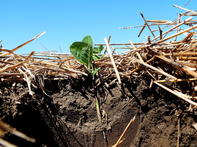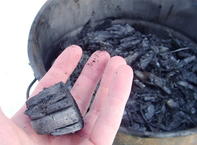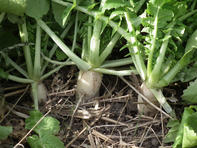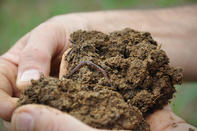Soil texture is determined by the combination of sand, silt and clay particles. Sandy soils have large particles, are coarse-textured and retain little water and few nutrients.

On the other side of the spectrum are clay soils with small clay particles. Clay soils are often heavy, waterlogged and hard to till, but can be nutrient-rich. In between sandy and clay soils are combinations of sand-loam-clay soils, more suitable for crop production. It is recommended to choose suitable crops for your soil type.
For example, trees, roses, spinach, beetroot, onions and grains may thrive in clay soil while crops like carrots, radishes, potatoes, tomatoes and maize prefer lighter sandier soils. Very few farmers have the ideal soil type.
Most farmers struggle with poor dry and infertile sandy soils or waterlogged and heavy clay soils. Fortunately, there are ways to improve soil texture and structure, most often by adding organic matter in the form of manure and cover crops.
How to Improve Sandy Soils

To improve sandy soil, the soil needs to be able to hold more nutrients. Some farmers use coal dust or ‘biochar’. This substance absorbs nutrients and slowly releases it into the soil.
It is mixed with fresh and moist animal manure and left for 2 - 3 weeks. ‘Biochar’ can also be mixed with liquid fertiliser and should also be left for 2 - 3 weeks. Some farmers add mixtures of soil microbes or rock dust (if needed) to the charcoal dust before working it into the soil. Using composted manure in sandy soils can supply nutrients in a slow-release form.
Apply smaller quantities more often, rather than too much at a time. It is recommended to dig manure deeper into sandy soil and not leave it on the soil surface. However, using mulch on the surface can prevent water evaporation and reduce wind erosion. Prevent overgrazing on sandy soils. Rather cut fodder and supply it in a feeding lot.
How to Improve Clay Soils

Clay soils are often rich in nutrients, but if the soil pH is too high or low, nutrients may not be in a soluble form for plant roots to absorb. Depending on your crop, if pH is below 6 - too acidic - adjust with gypsum or agricultural lime.
Soil pH of over 7.5 can be lowered with soil sulphur. To improve water drainage from clay soils, prepare raised planting beds. Incorporate more organic matter such as leftover crops, leaves, grass cuttings and rotten manure.
Not only will this add nutrients to clay soil, but it will also help to break up the dense heavy soil structure. Planting cover crops can also help to improve the structure of clay soils.
Animal Manure and Soil Texture

Earthworms help with soil structure formation by mixing organic matter with soil particles. They also eat soil particles, bind them into stable micro-aggregates and excrete these as earthworm casts. This ‘earthworm manure’ is also called vermicast. Well-rotted animal manure from horses, cows and poultry is probably the most common soil amendment used to improve soil texture and quality.
If possible, choose manures for specific crops. Horse manure is rich in primary nutrients and suitable for fast growing vegetables, such as broccoli, cauliflower and lettuce.
Cow manure is high in nitrogen and used for leafy greens that require lots of nitrogen such as spinach and lettuce. Poultry manure is very potent and high in nitrogen. It is good for mixing in sandy soil to improve moisture retention and good for leafy greens.
By Marinda Louw